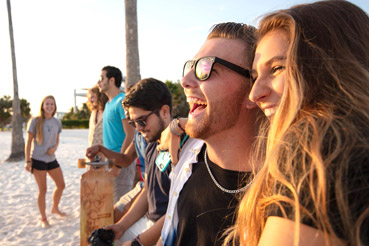The homepage of Rachel de Cuba’s website consists of exactly one image—a photograph of the front of a Hucks convenience store in Louisville, Kentucky. The image includes a trash can, some cigarette ads, two empty newspaper racks and something that’s decidedly out of place.
“It’s a traveling altar,” explains de Cuba, who recently began her first year as an assistant professor of visual arts and graphic design at Eckerd College. “I grew up in one place and in one house, so when I did a lot of moving around, I started carrying boxes that had mementos and keepsakes from different homes I had lived in.
“When I got to someplace new, I would open it up and just take stock of wherever I was. I never wanted to just go somewhere and live. I wanted to fully dive in. I’m very concerned about being a part of the community, not just being a transient.”
An interdisciplinary artist who grew up in Sebastian, on Florida’s east coast, de Cuba received her bachelor of fine arts degree in studio art at Flagler College in 2013 and her master of fine arts in digital art at Indiana University Bloomington in 2019. She later served as an associate instructor of art at IU. Most recently, she was an assistant professor of art at Clemson University.
In 2019, she was invited to create new media artworks for the New Orleans Film Festival with support from the Andy Warhol Foundation. Her work has been shown nationwide and was recently selected to exhibit in 701 Center for Contemporary Art’s 2021 South Carolina Biennial in Columbia, South Carolina. Her mixed media work has also been selected for publication in New American Paintings 2022 southern edition.
De Cuba served as the Provost Pathways Fellow in Art at Clemson and as a co-director of Tiger Strikes Asteroid Greenville, part of a nonprofit network of independently programmed, artist-run exhibition spaces.
“Focusing on familial narratives of migration, the works within my practice build upon the blended structure of an upbringing as a child of immigrants,” she says.
“Mesmerizing movements of multimedia apparatuses such as video and sound begin to open portals for viewers to engage with the heartache and uncertainty of oral histories in the power structure of the United States of America.
“While the digital materials look to surrealist approaches of storytelling,” she adds, “the physical materials explore the abstractions of narratives within a family heritage. My current studio practice marries craft and digital media to produce experiences in which viewers can engage in a series of questions while sitting in a tender space of vulnerability.”
One example of her ongoing interactive work is Be Kind To Me, a project in which participants fill out answers to questions about creativity and relationships. “The work has been done as a physical postcard-style response,” she explains, “and an ongoing archive is being built in order for folks to access the entries and experience the many layers of being creative.”
“There’s a lot of shock and awe in art right now,” she notes. “I want my work to be quieter … something you have to take some time with.”
De Cuba says she came to Eckerd because she was looking for a smaller college “where I could really connect with students. I’d like my students to feel the freedom to create and find their voice. I’m a facilitator, not a director. I want to hear their voice, see their passion. There are so many machines now that do what we do. But there’s no replacement for the authentic self.”
She is teaching motion graphics and special FX, typography, and graphic design during the Fall 2023 semester.

















